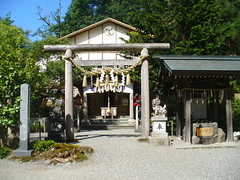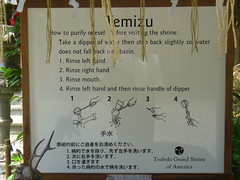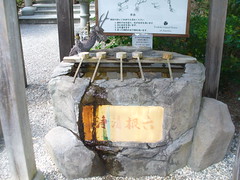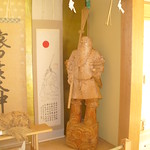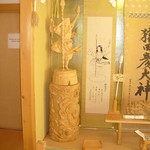Yesterday, my Mother and I drove to the Tsubaki Grand Shrine of America. It is a Shinto shrine – the only one in the continental United States – located in Granite Falls. It’s a little over a half an hour from Mom and Dad’s house, up into the mountains. It’s in a lush green spot, right on the Pilchuck river.
I haven’t mentioned Shinto much here, but maybe I will in another post. This one is for our trip to the shrine.
I’ve never been to a Shinto shrine before, but I’ve looked at a lot of the pictures of the Internet – Flickr is full of them – and read some descriptions, and even seen some video. They’re picturesque, and usually set in groves of trees, or other natural places. I can understand why people would take pictures.
The Tsubaki Grand Shrine of America looks like a Shinto shrine in Japan. It’s attractive and serene up in the foothills. It was far enough away from the roads that there wasn’t a lot of traffic noise, yet you could take a county bus to it. You enter the shrine through a giant wooden torii – the big gates –
and the main entrance is guarded by stone lions
. There were (electrically lit) lanterns on the paths, and five-sided signs to explain things. The entrance had a big shimenawa decorated with shide, a straw rope decorated with zig-zags, which denotes a sacred space. There was another set guarding a side shrine, and small ones over paths to the river, reminding that it itself is a kami. There was also a shimenawa around a truly magnificent old tree, marking it’s specialness. It all looked and felt right.
We got to the shrine about 10:30am, and had an 11:00am appointment for a ceremony. We spent the time before the ceremony walking around the grounds, and I took some pictures. We heard the beating of a drum inside, and moved over towards the building. We stopped and prayed as you would do without an appointment…
That’s actually a nice and simple little ritual.
First, you carefully purify yourself at the basin outside. It usually has running water and bamboo dippers, and Tsubaki America was no different.
You rise one hand, rinse the other, and then sip water (from your hand, not the dipper) to rinse your mouth, and finally let the water rinse the dipper handle. Once you’re purified, you approach the main doors to the shrine building. There’s a big rope there, attached to a bell. You can make a small cash offering in a box, shake the rope to ring the bell. Face the main shrine in the building, bow twice, clap twice, silently make your prayer, and then bow again.
It takes longer to write out than it takes to do, and is the basics of visiting the shrine and communicating with the enshrined kami there.
Since we had an appointment, we went to the door and were met by Reverend Koichi Barrish and his wife. I fear I didn’t get his wife’s name. Rev. Barrish took us upstairs to the reception room. We were served cups of green tea, and sat and discussed the weather, the photos in the photo album, the room, our travel to the shrine, some of the symbols used in the room and at the shrine, our recent visit to the Great Wheel in Seattle (Rev. Barrish is looking forward to the experience.), books I’d read about Shinto, and that Rev. Barrish knows one of the authors of those books. In essence, we chatted for a bit. Eventually, Rev. Barrish graciously asked us about what ceremonies we wanted, and we filled out a kito yoshi, a prayer request form, sorted out the details of the appropriate donation. We asked him to perform a ceremony to avoid misfortune, and the ceremonies for the crossing of the critical years of 40 and 70. I’m 40 and Mom is 70, and he was delighted to do that. He spoke highly of Mom’s brightness and clarity. He’s right, too!
Rev. Barrish went down to prepare, and we had a few more minutes in the reception room. It had some lovely art and woodcarvings of Sarutahiko-no-O-Kami
and Ame-no-Uzume-no-Mikoto,
the two primary kami enshrined there. That’s when I took my pictures. Mrs. Barrish came and escorted us down to the main room, where we sat before the shrine itself.
I was busy, and didn’t get any photos of the main floor. There’s a little entry where you remove your shoes and then a vestibule with the stairs up to the reception room and a couple of other little halls we didn’t explore. The main room is directly ahead, and draws the attention. It was a large, open room with cathedral ceilings, and windows around the upper edges to let in a lot of sunlight. The outer edge of the floors – a three foot border or so – was hardwood, and the rest was soft padded stuff. I know this is because they also teach Akido in this space, and Mom mentioned that she wondered where the basketball hoop went. It had that sort of big open feeling. It’s about square, if not actually square.
The far end of the room, away from the entrance, has a large alcove – most of the far wall. It’s raised up a couple of steps, and is full of Shinto paraphernalia. There were decorated spears and arrows, tables with offerings – incuding our kito yoshi and my check – and a large Japanese drum. The Tsubaki America web site has a picture. The far wall of that alcove contains a door which covers the enshrined kami.
We sat, facing the enshrined kami, while Rev. Barrish performed the ceremony. I think it was about 45 minutes long. All of the ceremony was in Japanese, except a few words of English to give us directions.
Rev. Barrish started at one side, and performed a chant, a general purification of the area if I understand right. He then moved on to the stage and picked up a rod with a lot of white paper shide – the white zig-zags – on the end. With more chanting, he waved it over us, whoosh whoosh whoosh. More purification, I think. He then moved to the center, directly in front of the kami, and read several of the Shinto norito. He read them in a loud droning voice that echoed around the room. There were several strikes of the big drum, which shook the room more. The combination vibrated all the way through you. I think those were our actual ceremonies. He also rang some golden bells, which I don’t know the significance of.
Rev. Barrish moved a small table to the front, and had us come up. We were each given a green branch – Mom says it was camellia, as the traditional sakaki doesn’t grow here – and presented them to the kami. We returned to our seats, and Rev. Barrish closed the ceremoy.
After the ceremony, we visited the gift shop, which is also in the main room, and picked up a few things for people as gifts. I picked up a copy of the CD of the Shinto norito, which I hadn’t seen before. I also saw the Shrine had shimenawa for sale, and picked one up for my kamidana. That’s nice because you just don’t find it anywhere else in the USA.
We went back to the entry and put our shoes back on, and said our goodbyes. Rev. Barrish mentioned to Mrs. Barrish that we’d been on the Great Wheel and she wanted to know all about it, which was charming. As we left, some others stepped up and said hello, in Japanese. I don’t think they went in for a ceremony, just said hello and talked to the Barrishes like they were old friends. I assume they were.
Mom and I walked down to the river, took a few last pictures, and headed out. I enjoyed the visit very much, and thought the Barrishes and the shrine were wonderful.

